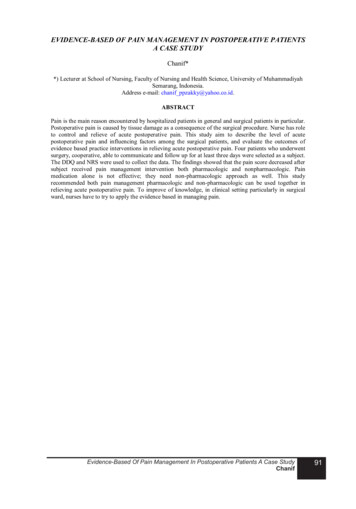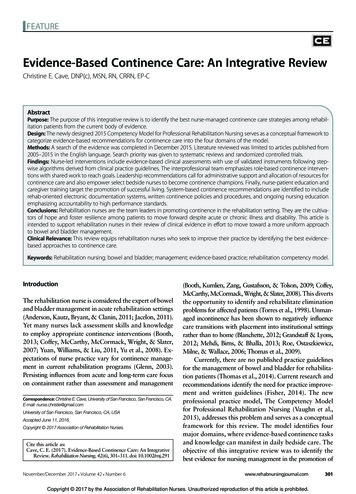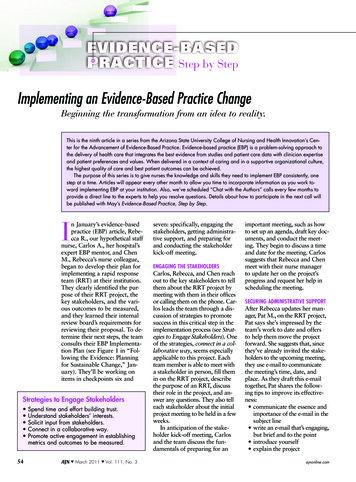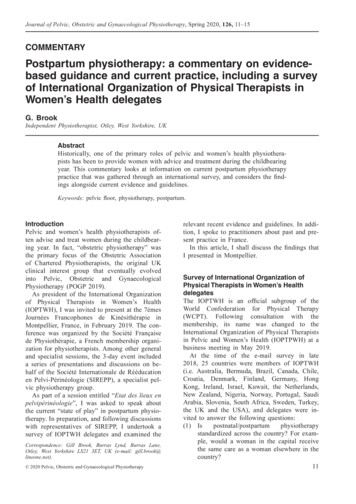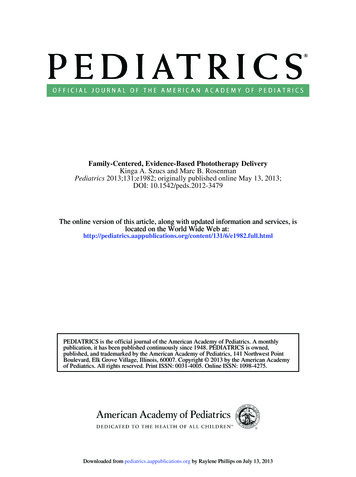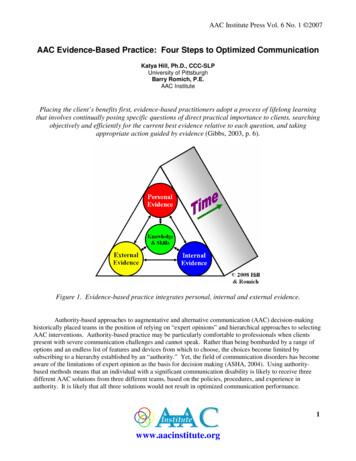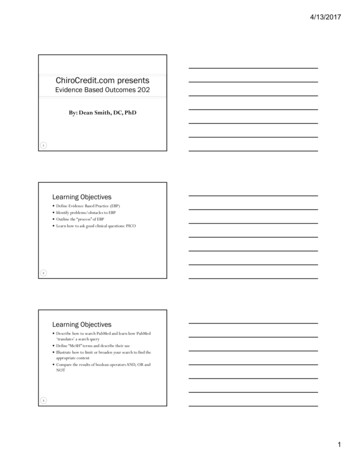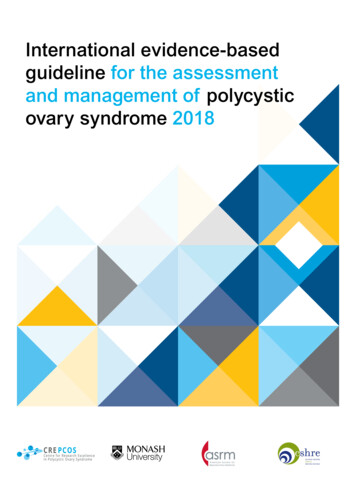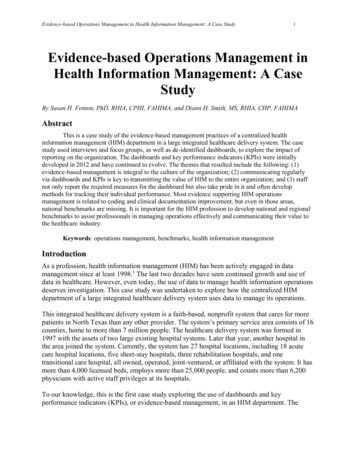
Transcription
Evidence-based Operations Management in Health Information Management: A Case Study1Evidence-based Operations Management inHealth Information Management: A CaseStudyBy Susan H. Fenton, PhD, RHIA, CPHI, FAHIMA, and Diann H. Smith, MS, RHIA, CHP, FAHIMAAbstractThis is a case study of the evidence-based management practices of a centralized healthinformation management (HIM) department in a large integrated healthcare delivery system. The casestudy used interviews and focus groups, as well as de-identified dashboards, to explore the impact ofreporting on the organization. The dashboards and key performance indicators (KPIs) were initiallydeveloped in 2012 and have continued to evolve. The themes that resulted include the following: (1)evidence-based management is integral to the culture of the organization; (2) communicating regularlyvia dashboards and KPIs is key to transmitting the value of HIM to the entire organization; and (3) staffnot only report the required measures for the dashboard but also take pride in it and often developmethods for tracking their individual performance. Most evidence supporting HIM operationsmanagement is related to coding and clinical documentation improvement, but even in those areas,national benchmarks are missing. It is important for the HIM profession to develop national and regionalbenchmarks to assist professionals in managing operations effectively and communicating their value tothe healthcare industry.Keywords: operations management, benchmarks, health information managementIntroductionAs a profession, health information management (HIM) has been actively engaged in datamanagement since at least 1998.1 The last two decades have seen continued growth and use ofdata in healthcare. However, even today, the use of data to manage health information operationsdeserves investigation. This case study was undertaken to explore how the centralized HIMdepartment of a large integrated healthcare delivery system uses data to manage its operations.This integrated healthcare delivery system is a faith-based, nonprofit system that cares for morepatients in North Texas than any other provider. The system’s primary service area consists of 16counties, home to more than 7 million people. The healthcare delivery system was formed in1997 with the assets of two large existing hospital systems. Later that year, another hospital inthe area joined the system. Currently, the system has 27 hospital locations, including 18 acutecare hospital locations, five short-stay hospitals, three rehabilitation hospitals, and onetransitional care hospital, all owned, operated, joint-ventured, or affiliated with the system. It hasmore than 4,000 licensed beds, employs more than 25,000 people, and counts more than 6,200physicians with active staff privileges at its hospitals.To our knowledge, this is the first case study exploring the use of dashboards and keyperformance indicators (KPIs), or evidence-based management, in an HIM department. The
2Perspectives in Health Information Management, Fall 2019authors believed this study was needed to demonstrate how data can be used effectively and tosuggest additional areas for HIM operations data analytics.This case study is important because it begins to build the foundation for evidence-based HIMoperations management. Hopefully, this case study will also be used by HIM educationalprograms.Literature ReviewThe HIM profession has approached data management from many different perspectives, yetpublications related to evidence-based HIM operations management are difficult to find. BothPubMed and the American Health Information Management Association (AHIMA) HIM Librarywere searched, revealing some research, most often related to patient record coding and clinicaldocumentation improvement.2, 3 Unfortunately, this focus does not encompass the entire range ofHIM operations, leaving out scanning and release of information, at a minimum. Other articlesare focused on more broad-based analytics, applicable to the delivery of healthcare rather thanthe management of HIM operations.4, 5 While valuable, this information does not assist HIMprofessionals in managing their day-to-day operations.Since approximately 2014, AHIMA, as the HIM professional association, has focused oninformation governance, performing studies and creating many resources for healthcareorganizations to implement information governance. In 2017, Houser and colleagues discussedthe need for information governance related to support for analytics.6 This article reviewedseveral models that can be used when managing the information needed for management, but itdid not address the actual use of the data and information for operations management. Likewise,the practice brief for data analytics reporting provides guidance regarding the reporting lifecycle,reporting methods, and tools for reporting; however, no actual example is provided.7The lack of a comprehensive review of evidence-based operations management in a case study orother form of research reveals a gap in the HIM literature. The following case study is expectedto provide only a starting point for evidence-based HIM operations management.MethodsThis case study is a joint project between a graduate program in health informatics and the largeintegrated healthcare delivery system. It was approved by the university’s Committee for theProtection of Human Subjects, approval number HSC-SBMI-18-0567.The methods chosen for conducting the analysis of the health delivery system’s evidence-basedHIM operations were interviews and focus groups over a two-day period. All interviewees andfocus group participants signed forms indicating their informed consent to participate in the casestudy. The questions included a description of the KPIs used, how they are selected andcalculated, and how data are collected for each KPI. They were also asked about the evolution ofthe KPI reporting and what they liked best or least about using and reporting KPIs. The focusgroup and interview questions were approved by the institutional review board and can be foundin Appendix A.
Evidence-based Operations Management in Health Information Management: A Case Study3The interviews were held with the vice president of health information management services(HIMS) and clinical documentation improvement (CDI), the direct supervisor, and the directreports to this position. Focus groups were held with the coding, clinical documentationimprovement, data integrity, release of information, and operations and regulatory complianceunits. Transcripts were made of all sessions, and grounded theory was used as the analysismethod. A total of 50 persons took part in the focus groups, with 6 persons interviewedindividually.Results and DiscussionThis case study explores the evidence-based management of a centralized HIM department. Forclarity, this study focuses on the reporting from each department to the VP of HIMS and CDI, aswell as to senior-level executives at the system level and executives at the entity level across thehealthcare organization.Themes that emerged from the interviews and focus groups are as follows:1. The focus on evidence-based management is pervasive across and throughout theorganization. Most, if not all, organizational units have dashboards to help them managetheir areas using KPIs.2. Communicating regularly via dashboards and KPIs not only enables more effectivemanagement but also ensures that senior management understands the impact of HIMoperations on the overall health of the organization.3. Setting and achieving goals gives the HIM and CDI personnel a sense of pride in doingtheir job well. The staff report measures beyond those required for the dashboard. Morethan one person reported having created their own dashboard to track their individualperformance.Organizational StructureThe HIM organization is centralized and complex, as might be expected when managing HIMoperations for 19 hospitals and related organizations. The organizational structure is found inFigure 1.The initial organizational structure was established in 2012 after a two-day rapid design sessionthat involved all HIM directors and managers along with representatives from human resourcesand information technology. Key objectives of the rapid design session were to design and buildthe enterprise HIM model, identify best practices, create performance specifications, and developmethods of communication. The organization designed a unified system approach to streamlineoperations and achieve excellence, with the long-term expectation of benchmarking operations.Consistent quality and timeliness of data reporting across the enterprise, with a focus ondeveloping and using leading-edge tools and enablers to consistently support a leveragedenterprise HIM model, was a key initiative. From the beginning, the organization developedstandardized KPIs to be included in a reporting matrix for each functional area. Performancebaselines were established to enable postimplementation comparisons. Over time, theorganizational structure evolved as responsibilities were added under the VP’s leadership.
4Perspectives in Health Information Management, Fall 2019Use of Dashboards and KPIsThe dashboards and KPIs for HIM operations have been in development for six years andcontinue to evolve. Staff who worked in other healthcare organizations or those who worked atthe healthcare delivery system before the centralization of HIM services experienced a period ofadjustment related to the extensive reporting and sharing of data. They reported initially feelingthat the dashboard reporting would be used as a “gotcha.” However, they discovered thatreporting the data allowed them to identify opportunities for improvement, as well as providingevidence that made it possible to celebrate achievements. Not all goals are achieved; this isconsistent with the practice of setting “stretch” goals.Data are gathered in a variety of ways from each staff member. Examples include turnaroundtimes for different types of requests for patient records; physician documentation compliance bydocumentation type; data integrity, as demonstrated by duplicate accounts; management ofrecord scanning; coding productivity and denials; and financial analysis of HIM operations. Thesummary HIM dashboard is seen in Figure 2, while Figure 3 shows the CDI dashboard. Topreserve confidentiality for the organization, the dashboards show synthetic data. The structureof the dashboards is accurate.In addition to an overall view of the measures for the integrated healthcare delivery system, eachhospital or separate organizational unit receives a dashboard detailing their performance for allof the measures. For example, the integrated health delivery system may be compliant with thestandard of 95 percent completion of history and physical update within 24 hours for a givenmeasurement period, while one or more of the hospitals or organizational units may not be incompliance with the standard.Using a dashboard over a long period does not guarantee problem-free management. During theinterviews and focus groups, participants noted issues that had recently been encountered in thereporting for release of information. Over several months, the staff reported that they believedthe dashboard numbers for a specific type of release request were incorrect; they contended thatthe numbers on the dashboard were not consistent with what they witnessed in their day-to-dayoperations. These reports prompted further investigation into the dashboard data that wereautomatically extracted from the electronic health record (EHR). It was eventually determinedthat a recent upgrade to the EHR had altered the reporting related to the release requests. Thisanecdote demonstrates that the frontline staff pay attention to the dashboard. Further, they feelempowered to report inconsistencies and discrepancies they discover in the data reported on thedashboard.BenchmarksAs reported by the healthcare organization employees, benchmarks are an essential componentof a useful dashboard. However, as seen in Figure 2, 41 of the 55 measures, or approximately74.5 percent of the HIM operational measures used by this data-driven organization have nocomparable industrywide benchmarks. Although the organizational performance data issynthetic, the industry and organizational benchmarks are accurate. This lack of comparable
Evidence-based Operations Management in Health Information Management: A Case Study5benchmarks was the topic of a recent Journal of AHIMA article focused on coding accuracy.8 Itis reasonable to suggest that this lack of comparable industrywide benchmarks applies to amajority of HIM operations.Careful attention to Figure 2 reveals multiple measures where the organization’s standard ismuch stricter than the industry standard or there is an organizational standard without an industrystandard. For example, in the release of information category, the organizational standard forcontinued care request turnaround time is 7 days, whereas the Texas requirement is 15 days. Theorganizational standard for stat request turnaround time is 30 minutes; there is no industrystandard. Similarly, the organization’s standard for medical record delinquency rate is 25percent, as opposed to the Joint Commission standard of 50 percent. Both management and staffreport that the use of the dashboard and KPIs has resulted in an overall lowering of theorganizational targets over time, demonstrating performance improvement.Use of the dashboard over time can also assist the HIM department with compliance and externalaudits. In this organization, the transcription section was required to undergo an external audit ofthe data reported in the dashboard. (This is a standard practice at many large organizations.External auditors examine different practices and processes in the organization to ensureaccuracy and compliance with regulations.) All of the transcription data were reviewed foraccuracy. The data collection sources were examined, as were the numbers reported. Because ofthe documentation supporting the processes and the data collected, the audit resulted in norecommendations for improvement.Additional ConsiderationsThe current dashboard used by this healthcare delivery system has evolved over several years tomeet the business needs of the organization and to align with strategic goals of the enterprise.The dashboard not only contains data from a system perspective; it also contains data at thehospital level, allowing transparency and benchmarking. It was important to the organization tocreate a culture of transparency that demonstrates the value of a centralized HIM model. Leadersacross the enterprise use the dashboard data to identify patterns or trends and to perform internalcomparisons with hospitals of similar size. This level of transparency has created a truepartnership for improvement on specific measures between HIM and other departments withinthe organization. The dashboard has allowed improvement in HIM operations and in qualityoutcomes through collaborative efforts across the enterprise. More than one person reported thatstakeholders look for the monthly dashboard and appreciate the level of transparency.HIM professionals wishing to initiate a dashboard should choose a starting point. This startingpoint could be a single measure or a single organizational unit. For example, coding might bereasonable because HIM departments commonly track their coding productivity. Once thisreporting is standardized and everyone is comfortable with the reporting, additional units such asrelease of information or documentation compliance can be added until all operations under HIMsupervision have KPIs included on the dashboard.Limitations
6Perspectives in Health Information Management, Fall 2019As with all case studies, one of the limitations of this study is the examination of a singleorganization. Other HIM departments in other healthcare delivery organizations are likely tohave different needs for their reports and/or dashboards, so these results cannot be generalized.Additionally, the subjective nature of the case study method may influence the results, a casestudy can be difficult to replicate, and case studies are time consuming.ConclusionThis case study is the first thorough examination of evidence-based HIM operationsmanagement. As such, it exposes both challenges and benefits of using data to manageoperations. Initial challenges include securing employee cooperation for a new managementprocess, efficiently collecting the data, and producing the dashboard in a timely fashion. Benefitsinclude substantiation of HIM operations effectiveness, HIM professionals’ pride in their jobs,and validation of HIM reporting under internal or external review.This study especially noted a lack of industrywide benchmarks that would be useful for HIMoperations management. This deficiency should be concerning for the HIM profession as databecome ever more ubiquitous and important in all aspects of healthcare delivery. AHIMA is thelogical organization to lead the effort to collect HIM operations management data that itsmembers can use for analytics and evidence to support operations. AHIMA could become asource of benchmarks and a resource for the healthcare industry.Susan H. Fenton, PhD, RHIA, CPHI, FAHIMA, is associate professor and associate dean foracademic affairs in the School of Biomedical Informatics at the University of Texas HealthScience Center in Houston, TX.Diann H. Smith, MS, RHIA, CHP, FAHIMA, is vice president of health informationmanagement services and clinical documentation improvement at Texas Health Resources inArlington, TX.
Evidence-based Operations Management in Health Information Management: A Case Study7Appendix AFocus Group and Interview Questions Outline1. Can everyone please introduce yourself, including your position at XXX, the unit andhow long you have worked in your position?2. Tell me about the KPIs you either use for your job or your unit uses to reportperformance. How many KPIs do you use? How were they chosen? Can you give medetails about their calculation? How do you collect data for these KPIs?3. Are these the same KPIs you have always used or has there been an evolution? If therehas been an evolution can you walk me through that process? Where did you begin withthe KPIs? How have they been changed or modified over time?4. Can you tell me about any reports or other documents that you would believe helpful tothe case study? All documents will be cleared by the XXX co-investigator forappropriateness.5. How has using/reporting the KPIs changed how you do your job or how you view yourjob or the requirements of your job?6. What do you like best about using and reporting KPIs? What would you change about itif you could?7. Is there anything else you would like to share with me about your job, your unit, andperformance monitoring at XXX?8. Can I answer any questions for you?
8Perspectives in Health Information Management, Fall 2019Notes1. AHIMA Data Quality Management Task Force. “Data Quality Management Model (1998)—Retired.” AHIMA, June 1998. Available at http://bok.ahima.org/doc?oid 105639.2. Wang, Tiankai, and Jackie Moczygemba. “Analyzing ICD-10 Diagnosis Codes with Stata.”AHIMA, May 2018. Available at http://bok.ahima.org/doc?oid 302491.3. Czahor, Amy. “How Analytics Can Direct and Improve Clinical Documentation.” Journal ofAHIMA 88, no. 9 (2017): 36–39.4. Butler, Mary. “Niche Analytics: Specialty and Non-Acute Data Analytics Initiatives OfferFocus and Opportunity for HIM.” Journal of AHIMA 89, no. 9 (October 2018): 16–19.Available at http://bok.ahima.org/doc?oid 302586.5. Thomas, Felicia A., and Wahiyda A. Harding. 2018. “Data Analytics: The Power of CodedData.” Journal of AHIMA 89, no. 9 (October 2018): 48–49. Available athttp://bok.ahima.org/doc?oid 302591.6. Houser, Shannon H., Donna J. Slovensky, and Luona Wang. “
Since approximately 2014, AHIMA, as the HIM professional association, has focused on information governance, performing studies and creating many resources for healthcare organizations to implement information governance. In 2017, Houser and colleagues discussed the need for informatio

